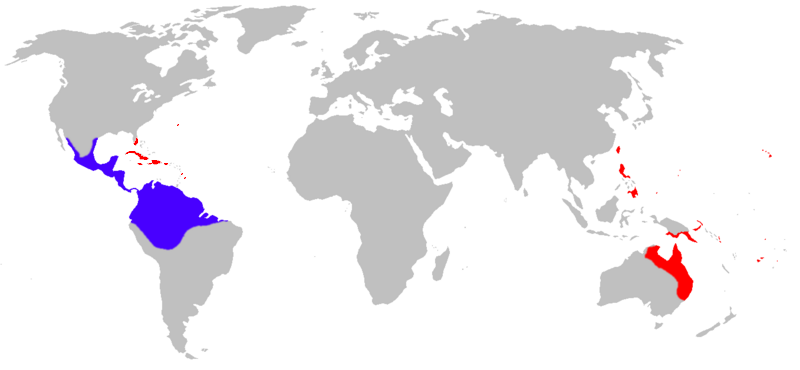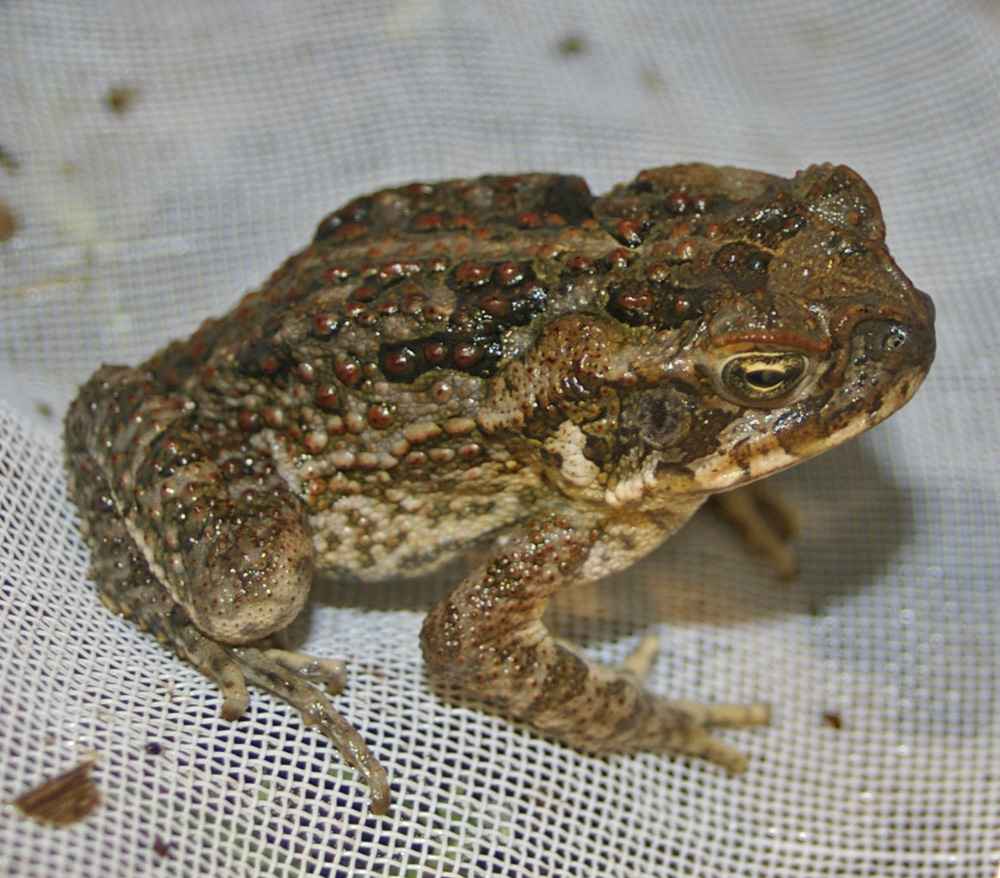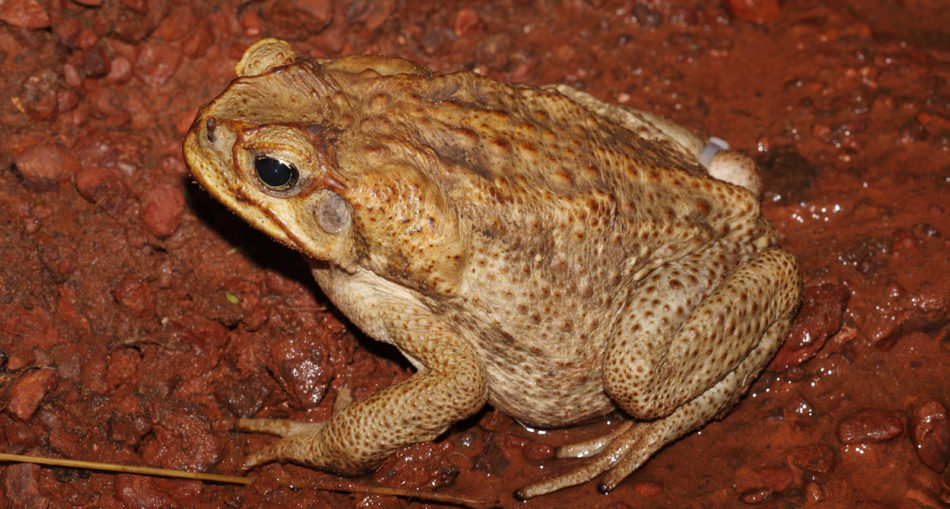Cane toads are the world’s largest toads and belongs to the genus Rhinella. It is a terrestrial toad native to Central America and South America (Guyana). The toad is known for its poisonous gland which secretes a substance that causes irritation to the predator’s body, especially the eyes. The tadpole is also highly toxic and may cause death to animals that ingest them. The cane toad has a voracious appetite and has been introduced in some parts of Pacific and Caribbean islands as pest control method. The name “Cane” is derived from its use in the control of cane beetle. In some of the introduced regions, the toad is now categorized as an invasive species.
Cane toads are the world’s largest toads and belong to the genus Rhinella. It is a terrestrial toad native to Central America and South America (Guyana). The toad is known for its poisonous gland which secretes a substance that causes irritation to the predator’s body, especially the eyes. The tadpole is also highly toxic and may cause death to animals that ingest them. The cane toad has a voracious appetite and has been introduced in some parts of Pacific and Caribbean islands as a pest control method. The name “Cane” is derived from its use in the control of cane beetle. In some of the introduced regions, the toad is now categorized as an invasive species.

Distribution | By Created by LiquidGhoul, ammended by Tnarg 12345 – in Wikipedia in English., CC BY-SA 3.0, https://commons.wikimedia.org/w/index.php?curid=1073153
Features Of The Cane Toad
- Colour – The skin of the cane toad is dry and warty. It has distinct ridges above the eyes, which run down the snout. Individual cane toads can be grey, yellowish, red-brown, or olive-brown, with varying patterns. A large parotoid gland lies behind each eye. The ventral surface is cream-coloured and may have blotches in shades of black or brown.
- Eyes, Toes & Fingers – The pupils are horizontal and the irises golden. The toes have a fleshy webbing at their base, and the fingers are free of webbing.
- Length – The cane toad is very large; the females are significantly longer than males, reaching a typical length of 10–15 cm (4–6 in), with a maximum of 24 cm (9.4 in). Larger toads tend to be found in areas of lower population density.
- Juveniles – Typically, juvenile cane toads have smooth, dark skin, although some specimens have a red wash. Juveniles lack the adults’ large parotoid glands, so they are usually less poisonous. The tadpoles are small and uniformly black, and are bottom-dwellers, tending to form schools. Tadpoles range from 10 to 25 mm (0.4 to 1.0 in) in length.

Yound Cane Taod | By Bidgee – Own work, CC BY 3.0, https://commons.wikimedia.org/w/index.php?curid=3869472
Scientific Classification Of The Cane Toad
Cane Toad – Rhinella marina [Scientific name]
- Kingdom: Animalia
- Phylum: Chordata
- Class: Amphibia
- Order: Anura
- Family: Bufonidae
- Genus: Rhinella
- Species: R. marina
Introduction Of The Cane Toad – How It Became A Pest Control Method In Many Countries As Well As An Invasive Species!
The cane toad has been introduced to many regions of the world—particularly the Pacific—for the biological control of agricultural pests. These introductions have generally been well documented, and the cane toad may be one of the most studied of any introduced species.
Before the early 1840s, the cane toad had been introduced into Martinique and Barbados, from French Guiana and Guyana. An introduction to Jamaica was made in 1844 in an attempt to reduce the rat population. Despite its failure to control the rodents, the cane toad was introduced to Puerto Rico in the early 20th century in the hope that it would counter a beetle infestation ravaging the sugarcane plantations. The Puerto Rican scheme was successful and halted the economic damage caused by the beetles, prompting scientists in the 1930s to promote it as an ideal solution to agricultural pests.
As a result, many countries in the Pacific region emulated the lead of Puerto Rico and introduced the toad in the 1930s. Introduced populations are in Australia, Florida, Papua New Guinea, the Philippines, the Ogasawara, Ishigaki Island and the Daitō Islands of Japan, most Caribbean islands, Fiji and many other Pacific islands, including Hawaii. Since then, the cane toad has become a pest in many host countries and poses a serious threat to native animals.
Tip: In Australia – About 3,000 cane toads were released in the sugarcane plantations of north Queensland in 1935. They now number well into the millions, and their still expanding range covers thousands of square miles in northeastern Australia. They are considered pests, and government eradication efforts include asking residents to help collect and dispose of them.
Habitat & Diet Of The Cane Toad
The cane toad inhabits open grassland and woodland and has displayed a “distinct preference” for areas modified by humans, such as gardens and drainage ditches. In their native habitats, the toads can be found in subtropical forests, although dense foliage tends to limit their dispersal.
Cane toads eat a wide range of material; in addition to the normal prey of small rodents, reptiles, other amphibians, birds, and even bats and a range of invertebrates, they also eat plants, dog food, and household refuse.
Reproduction Of The Cane Toad
The life of a cane toad begins as an egg, which is laid as part of long strings of jelly in water. In tropical regions, such as their native habitats, breeding occurs throughout the year, but in subtropical areas, breeding occurs only during warmer periods that coincide with the onset of the wet season. A female lay 8,000–25,000 eggs at once and the strings can stretch up to 20 m (66 ft) in length. The black eggs are covered by a membrane and their diameter is about 1.7–2.0 mm (0.067–0.079 in). The rate at which an egg grows into a tadpole increases with temperature.
Tadpoles: Tadpoles typically hatch within 48 hours, but the period can vary from 14 hours to almost a week. This process usually involves thousands of tadpoles—which are small, black, and have short tails—forming into groups. Between 12 and 60 days are needed for the tadpoles to develop into juveniles, with four weeks being typical. Similar to their adult counterparts, eggs and tadpoles are toxic to many animals. When they emerge, toadlets typically are about 10–11 mm (0.39–0.43 in) in length and grow rapidly. Growth typically slows once the toads reach sexual maturity.
About The Toxic Skin
The skin of the adult cane toad is toxic, as well as the enlarged parotoid glands behind the eyes, and other glands across its back. When the toad is threatened, its glands secrete a milky-white fluid known as bufotoxin. Components of bufotoxin are toxic to many animals; even human deaths have been recorded due to the consumption of cane toads. Dogs are especially prone to be poisoned by licking or biting toads. Pets showing excessive drooling, extremely red gums, head-shaking, crying, loss of coordination, and/or convulsions require immediate veterinary attention.
Did You Know? Bufotenin, one of the chemicals excreted by the cane toad, is classified as a class-1 drug under Australian law, alongside heroin and cannabis. As the cane toad excretes bufotenin in small amounts, and other toxins in relatively large quantities, toad licking could result in serious illness or death.
Five Facts About The Cane Toad
- They have a life expectancy of 10 to 15 years in the wild and can live considerably longer in captivity, with one specimen reportedly surviving for 35 years.
- The 1988 film “Cane Toads: An Unnatural History” is still a top ten bestseller in Australia, documenting the trials and tribulations of the introduction of cane toads in Australia.
- The species derives its common name from its use against the cane beetle (Dermolepida albohirtum).
- Its toxic skin can kill many animals, both wild and domesticated, and cane toads are particularly dangerous to dogs.
- In addition to releasing toxin, the cane toad is capable of inflating its lungs, puffing up, and lifting its body off the ground to appear taller and larger to a potential predator.
Cane Toads In Guyana
Yes, cane toads are the world’s largest toads and they can be found in Guyana. Be careful when around them because the skin is toxic and can lead to death. They have a voracious appetite and have been introduced to some countries as pest control methods. However, in some of the introduced regions, the toad is now classified as an invasive species.
Article References:
- https://www.worldatlas.com/articles/what-is-the-largest-toad-in-the-world.html
- https://en.wikipedia.org/wiki/Cane_toad
- https://www.facebook.com/296467910550212/posts/a-species-native-to-guyana-made-the-news-in-a-far-away-land-recently-cane-toads-/954537768076553/
- https://www.nationalgeographic.com/animals/amphibians/c/cane-toad/
- Main Image: Female Cane Toad | By Benjamint444 – Own work, GFDL 1.2, https://commons.wikimedia.org/w/index.php?curid=22702544








1 Comment